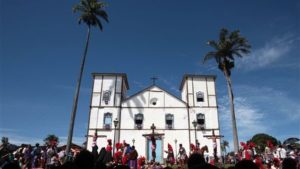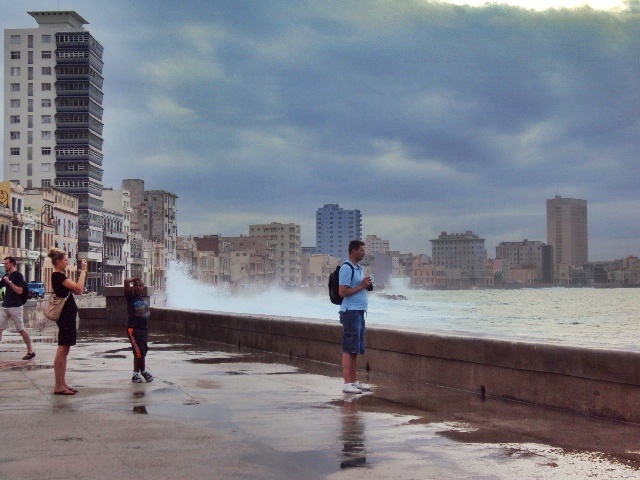 HOLY FRIDAY IN CUBA: A TRADICION NEVER FORGOTTEN. PHOTOS.
HOLY FRIDAY IN CUBA: A TRADICION NEVER FORGOTTEN. PHOTOS.
The Cuban authorities declared officially festive (when it should be said not to work, but not festive) two years after recovering the Christian celebration with the visit of Pope Benedict XVI.
After having been celebrated with “exceptional character” in 2012 and 2013, according to the new Labor Code, approved by the Parliament of the Island, it was recognized in Good Friday as the work break day of each year.
For more than half a century of Marxism, Leninism and dialectical materialism, the island slowly began to recover that tradition in April 2012, in response to an express request from Benedict XVI during his three-day visit to the island shortly before.
Although Good Friday has been recognized as a non-working holiday, the means of the Island almost never allude to the religious character of this theme, as it happens with Christmas, restored on the Island in 1998 (on the occasion of the visit of John Paul II) , within the framework of a decade in which religiosity recovered public spaces, after a marginalization that spanned twenty or thirty years.
In Cuba they were marginalized, in the political, professional or intellectual life, numerous practitioners of the Christian religions, and particularly the Catholics, and the Jehovah’s Witnesses, were badly seen by a system that bombarded the Cubans with acrimonious anti religious propaganda.
However, after the arrival to power of Raúl Castro in 2006, precisely the Catholic Church, with Jaime Ortega at the head, has become one of the main interlocutors of the government and has gained prominence in Cuba.
According to the Catholic religion, Good Friday takes place the Liturgy of the Passion of the Lord, at mid afternoon of that day and always before six o’clock. The priest and the deacon wear red ornaments, in memory of the blood shed. Before starting the ceremony, the temple is presented with the lights off, and the Cross is offered in veneration.
In many places of the world, including the Vatican (in Cuba it is transmitted by television) commemorates Good Friday with the prayer of Via Crucis (way of the cross), where through fourteen stations are remembered the steps of Jesus on his way death. It is also customary in some places to meditate on the Seven Words that Jesus pronounced on the Cross.
The custom of the holiday comes from several religions, including Protestant, established the abstention to perform all worldly works, because the commemoration, solemn, originated in the death of Christ. In Spain, Latin America, and the Philippines, processions with the cross on andas are popular. Lately they also happen in Cuba, even in the Plaza de la Catedral, in the heart of Old Havana, in an attempt to reactivate a tradition that never quite died.
VIERNES SANTO EN CUBA: UNA TRADICIÓN NUNCA OLVIDADA.
Las autoridades cubanas declararon oficialmente festivo (cuando se debiera decir no laborable, pero no festivo) dos años después de recuperar la celebración cristiana con la visita del papa Benedicto XVI.
Después de haber sido celebrado con “carácter excepcional” en 2012 y 2013, según el nuevo Código de Trabajo, aprobado por el Parlamento de la Isla, se reconoció en 2014 el Viernes Santo como día de receso laboral de cada año.
Durante más de medio siglo de marxismo leninismo y materialismo dialéctico, la Isla comenzó lentamente a recuperar esa tradición en abril de 2012, como respuesta a una solicitud expresa de Benedicto XVI durante la visita de tres días que hizo poco antes a la isla.
Aunque se ha reconocido el Viernes Santo como feriado no laborable, los medios de la Isla casi nunca aluden al carácter religioso de este tema, como ocurre con la Navidad, restituida en la Isla en 1998 (con motivo de la visita de Juan Pablo II), en el marco de una década en la cual la religiosidad recuperó espacios públicos, luego de una marginación que abarcó veinte o treinta años.
En Cuba fueron marginados, en la vida política, profesional o intelectual, numerosos practicantes de las religiones cristianas, y particularmente los católicos, y los Testigos de Jehová, eran mal vistos por un sistema que bombardeaba a los cubanos con enconada propaganda antirreligiosa.
Sin embargo, tras la llegada al poder de Raúl Castro en 2006, precisamente la Iglesia Católica, con Jaime Ortega a la cabeza, se ha convertido en uno de los principales interlocutores del gobierno y ha ganado protagonismo en Cuba.
Según la religión católica, el Viernes Santo tiene lugar la Liturgia de la Pasión del Señor, a media tarde de ese día y siempre antes de las seis. El sacerdote y el diácono visten ornamentos rojos, en recuerdo de la sangre derramada. Antes de iniciar la ceremonia, el templo se presenta con las luces apagadas, y la Cruz se ofrece en veneración.
En muchos lugares del mundo, incluido el Vaticano (en Cuba se transmite por televisión) se conmemora el Viernes Santo con el rezo del Vía Crucis (camino de la cruz), donde a través de catorce estaciones se rememoran los pasos de Jesús camino a su muerte. También es costumbre en algunos lugares la meditación de las Siete Palabras que Jesús pronunció en la Cruz.
La costumbre del día feriado proviene de varias religiones, incluidas las protestantes, establecían la abstención de realizar todas obras mundanas, debido a que la conmemoración, solemne, se originaba en la muerte de Cristo. En España, Hispanoamérica y Filipinas son populares las procesiones con la cruz en andas. Últimamente también ocurren en Cuba, incluso en la Plaza de la Catedral, en el corazón de La Habana Vieja, en un intento por reactivar una tradición que nunca llegó a morir del todo.
Agencies/CiberCuba/Joel del Rio/Internet Photos/ Arnoldo Varona/ TheCubanHistory.com
THE CUBAN HISTORY, HOLLYWOOD.







